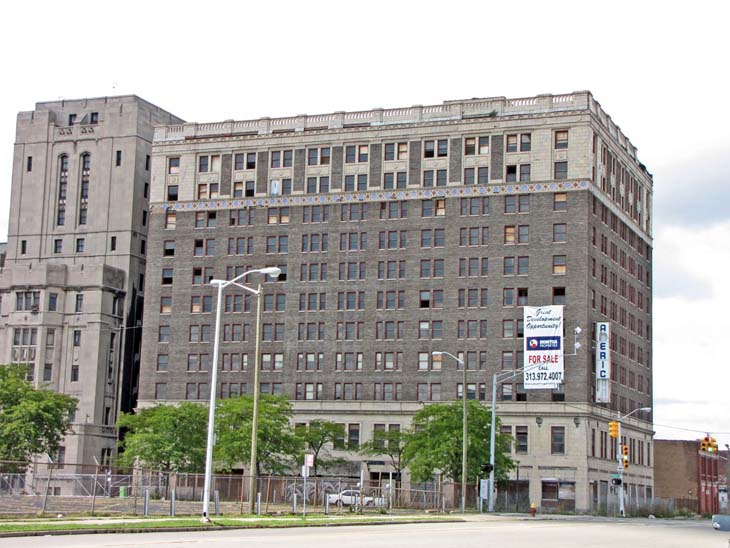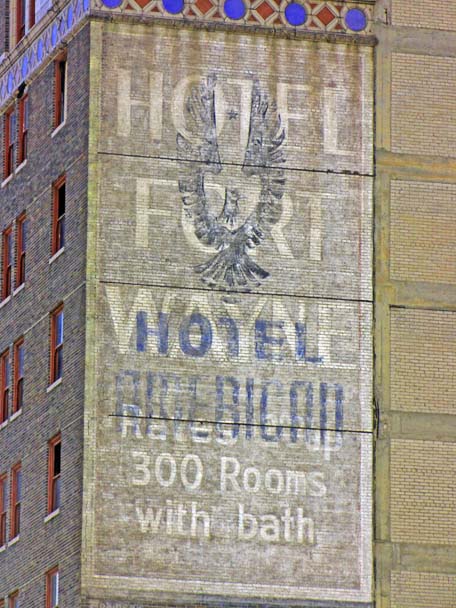

Numerous hotels were built in or near downtown Detroit in the 1920s. The now restored Book-Cadillac was the most prestigious of its era. Indeed, it may have been the most elegant hotel built in the downtown of a major city in the 1920s. Thousands of men arrived in Detroit by Pullman every week to do business with the booming vehicle firms, their suppliers and the financial institutions. They needed a place to stay, so upwards of a dozen large hotels were erected in that era. Several of them – the Eddystone, the Park Avenue and the Royal Palm were built along Park Avenue. This one was constructed on Cass adjoining the huge Masonic Temple Building, a structure that includes hundreds of hotel rooms. When built, the Hotel Fort Wayne faced an appealing Cass Park with numerous hotels and restaurants within a short walk. At that time this area was not severed from downtown by the Fisher Freeway.
Architects Watson and Ellington designed three large buildings that still stand near downtown Detroit. The Metropolitan Building, currently vacant, is the most appealing and innovative of their contributions to the city’s architectural heritage. Their Park-Shelton building in Detroit’s Cultural Center was recently modernized and converted into condominiums. The Hotel Fort Wayne is not a memorable building. It appears to be a functional hotel, presumably designed to capture a share of the city’s hospitality business. However, I never saw this building in its glory years, so it may once have been quite interesting. The hotel remained in business until 1990 but, I believe, has been idle for two decades. At some date, the name American replaced Fort Wayne but a careful look at the building from Cass reveals a sign announcing its original appellation.
On the Detroit websites, you can read speculation that the Illich interests may someday erect a large new arena for the Detroit Red Wings, and perhaps also for the Detroit Pistons. Most likely, this would be located on nearby acreage between Cass Park and Woodward. If that happens, and if civic leaders successfully develop the facilities and halls needed to make Detroit a city that attracts the biggest national and international conventions and trade shows, it might profitable for an entrepreneur to renovate Hotel Fort Wayne.
This hotel was named for General Anthony Wayne who was responsible for controlling or driving Indians out of present-day Ohio in the 1790s. General Wayne served with honor in the Revolutionary War and then moved to Georgia where he served briefly in Congress. After the Revolution, Americans sought to settle Ohio and Indiana but met strong opposition from the Indians who, from time to time, obtained arms and munitions from the British who still had their forts in the Northwest Territories. President Washington did not want to initiate another war with Great Britain but he came under considerable pressure to send troops to Ohio to protect the settlers. His original approach, in 1790 and 1791, was a low-key one involving few troops. They engaged the Indians in what became known as the Northwest Indian Wars. The Indians were, originally, quite successful in holding off the American troops. Realizing that his forces might be defeated, President Washington, in 1792, called General Anthony Wayne out of retirement to lead a “Legion of the United States” that would defeat the Indians. General Wayne pursued the Indians much more aggressively and defeated them soundly at the Battle of Fallen Timbers on the banks of the Maumee south of Toledo in August, 1794. The next year, the defeated Indians signed the Treaty of Greenville conceding much of Ohio to the American settlers. Realizing that it would not be easy to recolonize the United States, the British, in 1796, signed Jay’s Treaty giving up their claim to the Northwest Territories. Because of his accomplishments in driving the Indians out of Ohio, thereby allowing Americans to settle Ohio, Indiana and Michigan; cities, counties, universities, forts and hotels bear General Wayne’s name to this day.
Architects: William C. Watson and Harold S. Ellington
Date of Completion: 1926
Use in 2010: Abandoned hotel property awaiting reuse
City of Detroit Designated Historic District: Not listed
State of Michigan Registry of Historic Sites: Not listed
National Register of Historic Places: This hotel is within the Cass Park
Historic District: #04001580, Listed February 2, 2005.
Photograph: Ren Farley
Description prepared: November, 2010
Return to Hotels
Return to Homepage